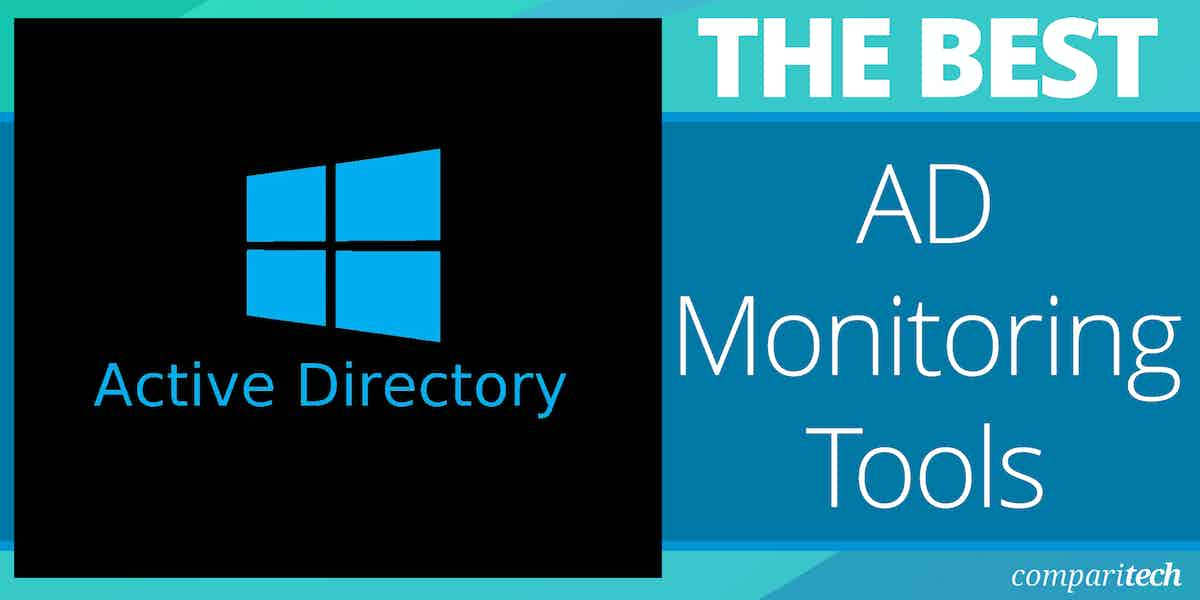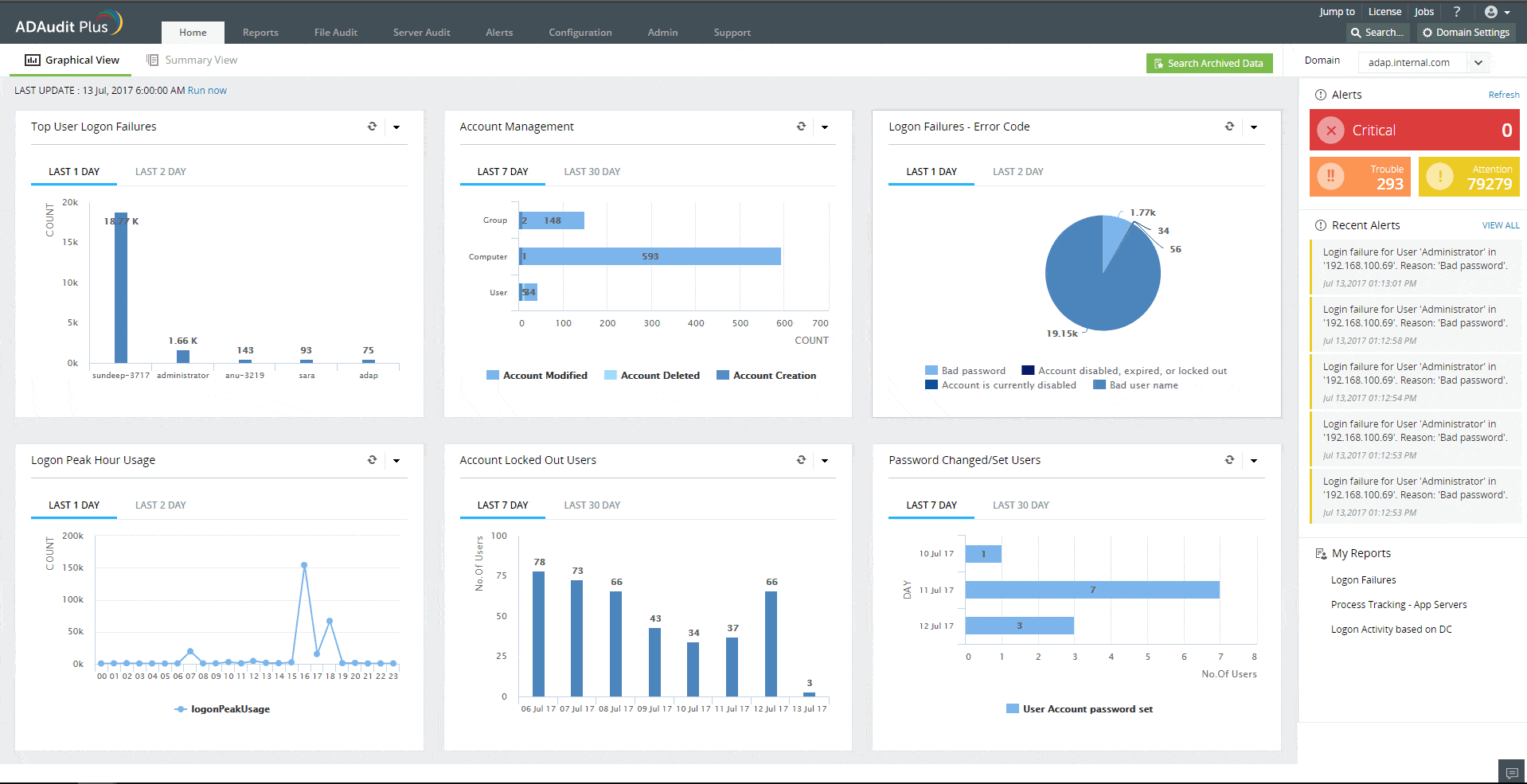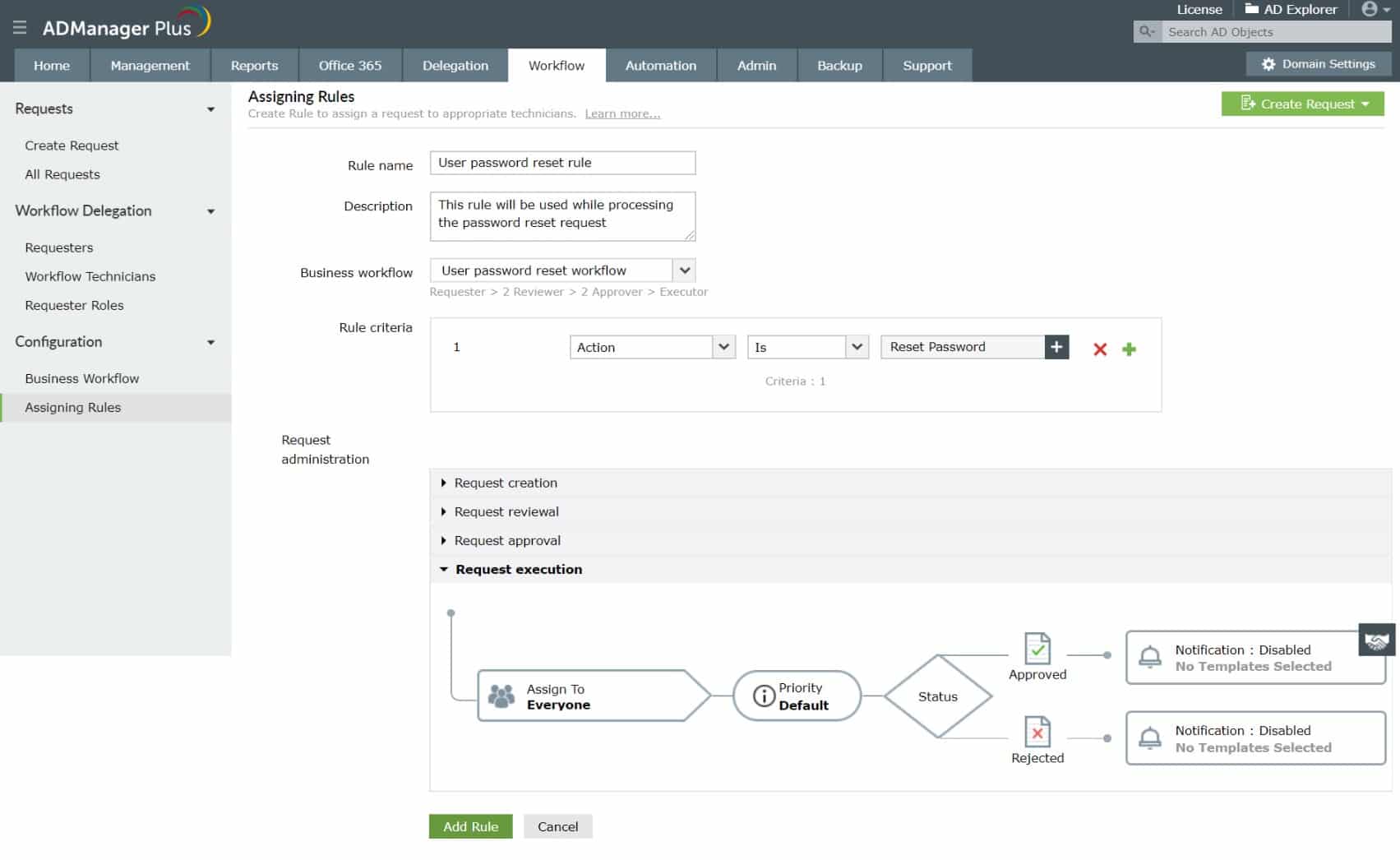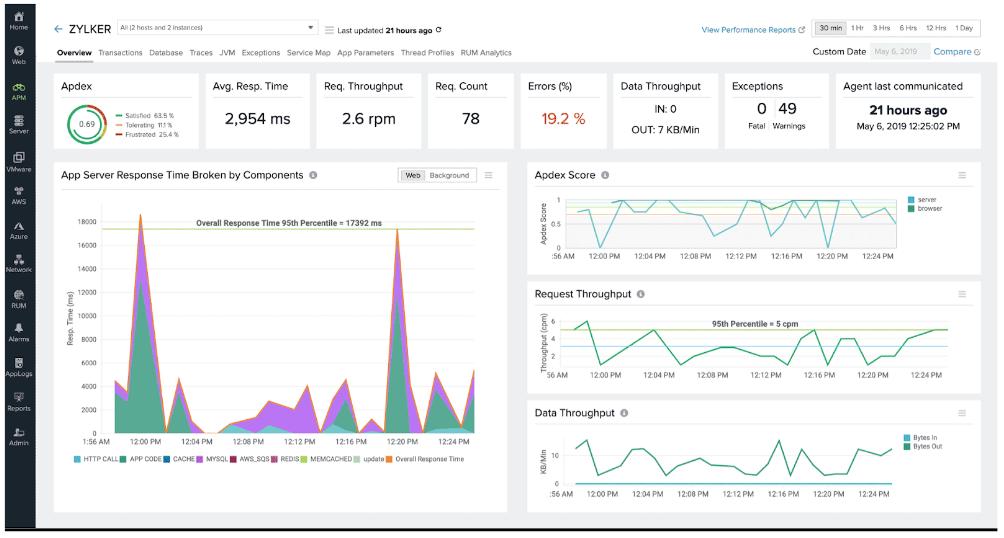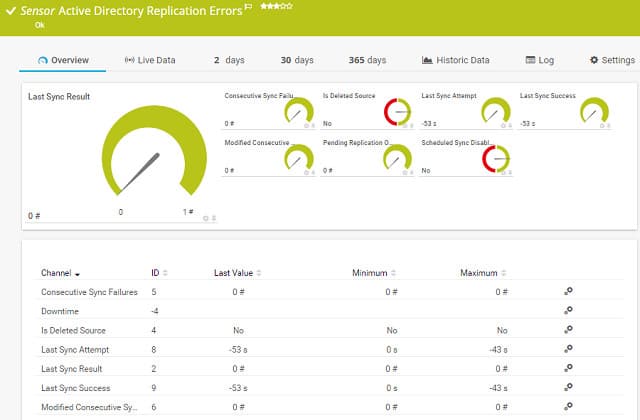As it is integrated into Windows Server, Active Directory is the first choice of most Windows-based businesses for access rights management. The smooth operations of Active Directory are vital for all business applications. If a performance problem occurs in AD, everyone gets locked out of the resources that they need in order to do their jobs.
There are many aspects of managing Active Directory that can be improved by the use of third-party tools. However, this review will focus on AD Monitoring tools and not AD management tools – that is the subject of another review on this site.
The two main reasons to improve Active Directory monitoring are to prevent security problems and to keep the system running efficiently. So, the tools listed in this review will cover Active Directory security and performance.
Here is our list of the best tools for Active Directory monitoring:
- ManageEngine ADAudit Plus EDITOR’S CHOICE This system helps clean up and protect account data in Active Directory – a necessary step for the tool’s main aim, which is user activity tracking. Use this system to identify insider threats and account takeovers. Available for Windows Server, AWS, and Azure. Start a 30-day free trial.
- ManageEngine ADManager Plus (FREE TRIAL) A system that can centralize the management of all AD implementations in one place, giving account control and reporting functions. Runs on Windows Server. Get a 30-day free trial.
- Site24x7 APM (FREE TRIAL) This is a cloud-based service that covers many applications and also website performance. It has excellent AD health monitoring functions. Start a 30-day free trial.
- Paessler PRTG This package of monitoring tools includes several specialist AD monitoring services alongside other systems for monitoring networks, servers, and applications. Runs on Windows Server.
- LogicMonitor An AI-driven cloud-based system monitoring platform that includes extensive AD monitoring features among its network, server, application, and website monitoring services.
- SolarWinds Server & Application Monitor This is the best general applications monitor that you can get for Active Directory monitoring. This service monitors performance and also examiners replication and backup processes to make sure they work effectively. Runs on Windows Server.
- Quest Active Administrator This specialized Active Directory monitoring package has a lot of performance analysis features and provides excellent data visualizations. Available for Windows Server.
- Semperis Directory Services Protector This is a defense system for Active Directory that monitors both AD content changes and log file tampering and will automatically restore AD after the detection of unauthorized changes. Installed on Windows Server.
- SentinalOne Singularity for Identity This cloud-based AD monitor operates as a vulnerability scanner and monitors for unauthorized changes as well.
Active Directory monitoring for security
When tackling the issue of Active Directory security, we are not concerned with security packages that access data from Active Directory in order to tighten general system security. These Active Directory monitoring tools specifically look at the usage of Active Directory and focus on protecting that application and the data that it holds.
Active Directory monitoring for performance
As an app, running on a server, Active Directory is subject to the same potential performance issues as any other application. These issues range from locked resources, capacity shortages in processor power, memory, and disk space, and demand on the Active Directory system itself. Network interface activity on the host is another issue.
There are many application performance monitors available that cover Active Directory as well as other services. We will include the best of these in our list. However, there are also a number of specialized tools that focus exclusively on Active Directory monitoring and you shall read about those, too.
The Best Active Directory Monitoring Tools
Our methodology for selecting Active Directory tools
We reviewed the market for monitoring systems to watch over Active Directory and assessed the options based on the following criteria:
- A cloud monitoring system that can track the activity on all of the AWS load balancing tools
- A file integrity monitor that is able to block unauthorized changes to Active Directory
- Storage and analysis for Active Directory access logs
- A system that can refer to AD and add user information to all system activity records
Failed login monitoring - A free trial or a demo to assess the package before buying
- Value for money from an Active Directory monitoring system that can also cover other applications
You can read more about each of these options in the following sections.
1. ManageEngine ADAudit Plus (FREE TRIAL)
If you want a dedicated Active Directory monitoring package, ManageEngine ADAudit Plus is your best bet. It offers real-time auditing and reporting for all critical activities within AD, enabling administrators to track changes, identify potential threats, and maintain control over the environment. ADAudit Plus monitors user logon and logoff events, group modifications, password changes, and account lockouts. It also provides granular visibility into permission changes, file accesses, and GPO alterations.
Key Features:
- Change Logging: Tracks modifications within the Active Directory to safeguard against unauthorized changes.
- Account Management: Monitors account activities, aiding in the management of user privileges.
- Login Monitoring: Keeps an eye on user login attempts and behaviors for security analysis.
- User Behavior Insights: Analyzes patterns to detect potential security threats from within.
- Real-Time Monitoring: Continuously monitors Active Directory for any changes or suspicious activities and raises alerts for potential threats.
Why do we recommend it?
ManageEngine ADAudit Plus is a compliance system that provides user activity tracking. As AD is the primary source of user details for this user behavior analytics function, the package also protects AD instances against unauthorized changes. It logs all alterations to AD records for system protection.
The level of detail that the ManageEngine system provides ensures that organizations can detect and respond to unauthorized actions or misconfigurations promptly. The platform’s dashboard and customizable reports make it easy to access actionable insights, aiding compliance with standards like GDPR, HIPAA, and SOX. It includes predefined audit reports and alerts to identify anomalies such as privilege escalation or unusual logon patterns, which are potential indicators of insider threats or external breaches.
ADAudit Plus integrates with other IT management tools and supports advanced analytics, including machine learning-based anomaly detection. By delivering continuous monitoring and actionable alerts, ADAudit Plus empowers IT teams to safeguard their AD environment, improve accountability, and minimize downtime due to misconfigurations or security incidents.
The ADAudit Plus has a much wider scope than just protecting Active Directory records. It also logs all user activity, implementing file integrity monitoring and insider threat detection.
Who is it recommended for?
This tool provides important security procedures for any business that uses Active Directory for an ARM but it is particularly important for businesses that need to comply with data protection standards. The package provides compliance reporting for PCI DSS, HIPAA, GDPR, and other data protection standards.
Pros:
- Compliance Oriented: Focuses on meeting regulatory standards, ideal for businesses needing to adhere to compliance frameworks.
- Automation & Scripting: Supports automated tasks and customization through scripting, increasing efficiency.
- Intuitive Interface: Offers a user-friendly dashboard that simplifies navigation and operation.
- Privileged User Monitoring: Audits the actions of privileged users to ensure accountability and prevent misuse of administrative privileges.
- Integration with SIEM: Easily integrates with SIEM tools for wider threat detection.
Cons:
- Better for Larger Setups: Optimized for expansive environments, which might be overkill for smaller networks.
ManageEngine ADAudit Plus is delivered as a software package for Windows Server. It is also available as a service on AWS Marketplace and Azure Marketplace. There is a Free edition that will scan 25 workstations for user activity but it doesn’t include the full AD protection features of the paid edition. You can get the full Standard edition on a 30-day free trial.
EDITOR'S CHOICE
ManageEngine ADAudit Plus is our top pick for an Active Directory monitoring tool because of its comprehensive feature set, user-friendly interface, and detailed auditing capabilities. It excels in providing real-time insights into critical Active Directory (AD) activities, such as user logins, account changes, permission modifications, and Group Policy updates. This level of visibility is essential for maintaining a secure and well-managed AD environment, especially in organizations where compliance and security are top priorities. One of the most important services of ADAudit Plus is its ability to deliver instant alerts on suspicious activities, such as unauthorized privilege escalations or failed login attempts, which are often early indicators of potential breaches. The tool supports over 200 predefined reports that simplify the tracking of compliance metrics for regulations like GDPR, HIPAA, and SOX. These reports are customizable, ensuring they meet the specific needs of your organization while saving valuable time. ADAudit Plus works with other ManageEngine tools and third-party solutions, providing a centralized ecosystem for IT operations. Its well-planned dashboard and ease of use make it accessible to administrators of varying expertise levels, reducing the learning curve often associated with sophisticated monitoring tools. The software incorporates machine learning algorithms for anomaly detection, helping organizations proactively identify threats by flagging unusual behavior patterns. This proactive approach, combined with extensive auditing and reporting capabilities, makes ADAudit Plus an invaluable asset for maintaining security.
Download: Get a 30-day free trial
Official Site: https://www.manageengine.com/products/active-directory-audit/download-free.html
OS: Windows Server, AWS, and Azure
2. ManageEngine ADManager Plus (FREE TRIAL)
ManageEngine ADManager Plus is a combined management and reporting tool for Active Directory. The service is able to centralize the control of all of your Active Directory implementations and there is even a Free edition for small businesses that is limited to covering 100 AD objects.
Key Features:
- Unified AD Management: Centralizes control over Active Directory operations across different environments.
- Cloud & On-Premises Monitoring: Offers comprehensive coverage for both cloud-based and local AD instances.
- Template Library: Provides a vast selection of templates for streamlined AD management tasks.
Why do we recommend it?
ManageEngine ADManager Plus is the second ManageEngine product on our list. This system unifies the management of multiple Active Directory instances, covering implementations for Microsoft products as well as general system access and resource protection. The ManageEngine system reads in records from AD and then operates as a front end for Active Directory.
AD management functions are aided by a library of templates. This provides hundreds of options for the management of user groups, user, and device account settings. The system facilitates the bulk upload, adjustment, and creation of AD objects. Other functions include user password management and file server permissions management.
The ADManager Plus system is able to interface to your Microsoft 360, Exchange, Skype for Business, and Google Workspaces to enable a fully coordinated implementation of all your user accounts.
Who is it recommended for?
There is a Free edition of this tool that will manage up to 100 AD objects. The paid version is offered in two editions: Standard and Professional. There is also a backup and recovery option available for both paid editions, which can be added for a fee.
Pros:
- Compliance Reporting: Generates detailed reports for major compliance standards, facilitating adherence to regulations.
- Multi-Domain Support: Easily manages multiple domains from a single interface, enhancing administrative efficiency.
- Delegation Capabilities: Allows for task delegation, making it easier to manage helpdesk or NOC teams’ workflows.
- Permission Visualization: Enables clear understanding of share permissions and security group details.
Cons:
- Learning Curve: The platform’s breadth of features requires time to fully master.
As well as the Free edition, ManageEngine offers two paid plans: Standard and Professional. The higher plan includes Contact Management and Workflow Automation modules, among other extras. Whichever plan you choose, you get a software bundle for installation on Windows Server. It is also available on Azure and AWS Marketplace. You can get a 30-day free trial of the full ADManager Plus package.
3. Site24x7 APM (FREE TRIAL)
If you don’t want to install your Active Directory monitoring system on-site, then your best option for a system-wide application monitor with AD functions is the Site24x7 APM.
Key Features:
- DC Monitoring: Keeps track of domain controller performance and health.
- AD Statistics: Gathers important Active Directory activity metrics.
- Cloud-Based: Offers flexibility and scalability with its cloud-hosted nature.
Why do we recommend it?
Site24x7 APM is one of the packages of monitoring systems that are offered on the Site24x7 cloud platform. All of the plans provide a combination of monitoring tools that cover networks, servers, cloud platforms, services, and applications. All of the plans will provide Active Directory monitoring, which covers issues such as replication errors.
This application performance monitor has health monitoring features and good replication monitoring services. As it is based in the cloud, this service is not limited to monitoring facilities on one site. You can consolidate all of your AD monitoring tasks in this tool.
Who is it recommended for?
This package offers a good deal for SMBs because it delivers all of the system monitoring tools that a business needs in one package. You don’t just get Active Directory monitoring with Site24x7 plans. Subscription rates and capacity are at levels that suit small businesses. Larger companies pay supplements for more capacity.
Pros:
- Comprehensive Monitoring: Provides an all-in-one monitoring solution that covers various IT infrastructure components.
- Real-Time Discovery: Automatically detects and maps network devices and applications for up-to-date monitoring.
- User-Friendly: Designed with ease of use in mind, making it accessible for a wide range of users.
Cons:
- Detailed Platform: While powerful, the platform’s complexity may require a significant investment of time to navigate fully.
The Site24x7 APM is charged for by subscription. The pricing structure for the service is a little complicated. It has a base package and then a menu of add-ons. However, Active Directory monitoring is included in the core system. Site24x7 offers the APM on a 30-day free trial.
4. Paessler PRTG
Paessler PRTG is a very large collection of specialized monitoring tools, called “sensors.” You customize your installation by deciding which sensors to turn on and the price of the system depends on how many sensors credits you want. Among the list of sensors are a number of specialized Active Directory monitoring tools.
Key Features:
- Replication Error Tracking: Monitors for issues in Active Directory replication, ensuring reliability.
- Server & App Monitoring: Keeps an eye on server health and application performance alongside AD functions.
Why do we recommend it?
Paessler PRTG is a large package of system monitoring tools. It covers networks, servers, applications, and cloud platforms and it has some Active Directory monitoring capabilities. The AD monitoring services in PRTG are limited to recording replication errors. This is a useful service if you run multiple DCs.
The main Active directory monitoring service that you really need is the Active Directory Replication Errors sensor. The functions of this service are self-explanatory. They let you know when things go wrong with replication. Other tools let you see deactivated users, AD group membership, and application health statistics, such as server resource usage.
Who is it recommended for?
This package is a good choice for all sizes of businesses. It is offered as a SaaS platform and also as a software package for installation on Windows Server. The buyer pays for an allowance of sensors and then decides which to turn on. If you only activate 100 sensors, the package is free to use.
Pros:
- Versatile Monitoring: Utilizes multiple protocols for comprehensive network monitoring and discovery.
- Auto-Discovery: Reflects network changes quickly, maintaining an accurate inventory.
- Customizable Dashboard: Enables personalized monitoring views with a drag-and-drop editor.
- Wide Range of Alerts: Supports diverse alerting options, including SMS, email, and integrations.
Cons:
- Complexity: The platform’s extensive capabilities necessitate a commitment to learning its features.
While leaving Active Directory monitoring to PRTG, you can also activate other sensors in the bundle to give you network, server, and application monitoring all in one dashboard. All of the monitors in PRTG operate a system of alerts for developing problems and these can all be forwarded as notifications by email or SMS. PRTG installs on Windows Server and you can get it on a 30-day free trial.
5. LogicMonitor
LogicMonitor doesn’t produce a specific Active Directory monitoring service but it is on our list because it employs innovative AI-based techniques to identify problems with all applications, including AD.
Key Features:
- AI-Driven Predictions: Utilizes artificial intelligence to forecast capacity needs and performance issues.
- Integrated Monitoring: Correlates data across servers and applications for comprehensive insights.
- Cloud-Based Platform: Offers a scalable, cloud-hosted solution for application monitoring, including Active Directory.
Why do we recommend it?
LogicMonitor is a system monitoring package that specializes in tracking the performance of applications. The tool will monitor Active Directory instances along with all of your other applications. The system uses AI to predict resource shortages that will impact system performance. This is a cloud-based package.
This system will watch over Active Directory performance and spot when there seems to be a problem either in its host resource usage or in its network traffic. LogicMonitor also monitors Active Directory activity as part of its system-wide security monitoring procedures.
Who is it recommended for?
This system is sophisticated and suitable for mid-sized businesses. You need to have a high degree of system complexity in order to justify using this system, so it wouldn’t be suitable for small businesses. You will need to get the LogicMonitor Unified OInfrastructure Monitoring plan to get Active Directory monitoring.
Pros:
- Application Focus: Prioritizes application performance, ensuring Active Directory and other applications run smoothly.
- Hybrid Monitoring: Capable of overseeing assets in both cloud and on-premises environments with equal proficiency.
- Customizable Dashboards: Allows users to tailor the monitoring interface to suit their needs, enhancing user experience.
Cons:
- Short Trial Period: The 14-day free trial may be insufficient for thorough evaluation.
This is a cloud-based service and it deploys agents on-site to collect data. These agents run on Windows Server to monitor Active Directory. You can assess LogicMonitor on a 14-day free trial.
6. SolarWinds Server & Application Monitor
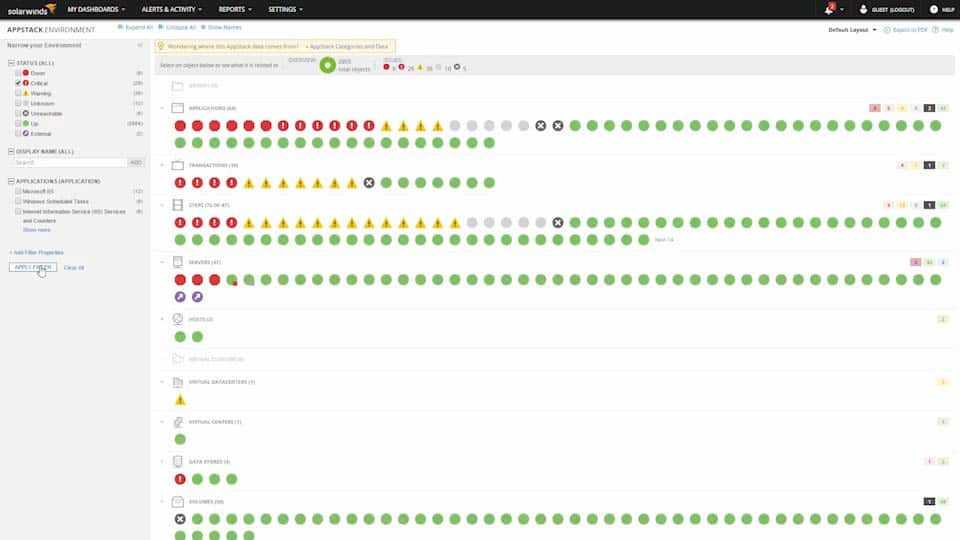
SolarWinds Server & Application Monitor watches over all applications and also the servers that host them. Among the capabilities of this tool are extensive Active Directory monitoring utilities. This monitor is particularly strong at watching over replication of AD settings and contents.
Key Features:
- AD Replication Monitoring: Ensures seamless replication across Active Directory environments.
- AD Activity Tracking: Collects detailed statistics on Active Directory operations.
- Audit Capabilities: Offers thorough auditing tools for Active Directory environments.
- App Dependency Mapping: Visualizes application dependencies to simplify management.
- Login Monitoring: Provides comprehensive reports on user login activities.
Why do we recommend it?
Active Directory is one of the systems that SolarWinds Server & Application Monitor covers. The package will also monitor Azure ADs. The console for the package creates a map of all AD domain controllers and how they relate to each other. The package also provides continuous performance checks, scanning for alerts in AD log files.
This monitoring system lets you see all of your AD controllers and their activities. It is able to consolidate monitoring for instances over several sites. The dashboard presents a summary for all AD controllers and then enables progressive drill-down to specific instances. It identifies configurations, schemas, forests, and controllers so you can better identify where coordination errors seem to have occurred.
The SolarWinds Active Directory monitoring service includes a system of alerts that will display on the dashboard if problems are detected. An alert can be forwarded as a notification by email or SMS. That means you can leave AD supervision to the Server & Application Monitor and assume everything is running smoothly unless you are otherwise notified.
SolarWinds Server & Application Monitor covers many different applications while providing thorough AD health analysis functions. This tool is particularly useful if you manage several sites and need to make sure that all of your user access rights are coordinated. You can confidently supervise remote Active Directory implementations with this monitoring tool.
Who is it recommended for?
This package runs on Windows Server, which gives it a common platform with Active Directory. The package can identify AD DCs on multiple sites and also Azure AD, so large businesses with a complicated ARM structure would benefit the most from this package. The tool will simultaneously track other applications.
Pros:
- Enterprise Scalability: Tailored for large network environments with extensive support for multi-site Active Directory structures.
- Auto-Discovery: Automatically identifies and maps network devices and applications, enhancing operational efficiency.
- Advanced Alerting: Features a sophisticated alerting mechanism that effectively notifies administrators of critical issues.
- Customizable Dashboard: Allows for a personalized monitoring experience with adjustable widgets.
- Comprehensive Reporting: Includes pre-set templates for compliance and performance reporting, streamlining administrative tasks.
Cons:
- Complex for Novices: Its extensive features and depth make it challenging for users without technical expertise.
The SolarWinds Server & Application Monitor installs on Windows Server and you can get it on a 30-day free trial.
You can enhance your activity tracking and log message management further by getting the SolarWinds Log Analyzer along with the Server & Application Monitor. These two modules are packaged together in the Log and Systems Performance Pack. The two units were built on a common platform called Orion and you access them both through a single dashboard. The Log Analyzer gives you the ability to set up automated alerts based on specific types of log messages, such as those generated by Active Directory. You can start with a 30-day free trial.
7. Quest Active Administrator
Quest Active Administrator offers AD management functions and also Active Directory monitoring services. In fact, the performance monitoring features in this tool are very strong. The focus of this monitoring tool is on spotting problems early before they become major issues. It examines the availability of resources on the host as well as the actual workings of AD itself.
Key Features:
- Comprehensive AD Management: Streamlines the oversight of Active Directory with centralized control.
- Performance Tracking: Monitors Active Directory’s performance, identifying issues before they escalate.
Why do we recommend it?
Quest Active Administrator is an on-premises software package that runs on Windows Server. The system provides a management interface for Active Directory and also implements AD monitoring. The system centralizes the management and monitoring of multiple domain controllers, which can be distributed across several sites.
This AD monitor provides a centralized dashboard for supervising all AD activities throughout the enterprise. The console includes an automatically created AD topology map that shows all of the relationships between your controllers and forests. As this map is live, it adjusts automatically, should you alter your AD infrastructure.
As well as providing live performance reporting, Active Administrator produces a daily activity summary, which includes a round-up of performance issues as well as the volumes of throughput handled by each AD server. The factors that are monitored by the tool include data flows in and out of the controller over the network with a visualization of that data in charts and graphs. Color-coded traffic statuses shoe bottlenecks and lead through to tools allowing you to fix the issue.
The Active Administrator covers all aspects of AD infrastructure from database issues through to replication statuses. You might find all of the data presented by the monitor a bit overwhelming – there are more than 100 factors that are constantly monitored and depicted. However, you can focus on those metrics that interest you most by customizing the dashboard screens, creating your top issues screen. You can also decide how information is portrayed by selecting text panels or graphical representations for live performance metrics. Active Administrator offers a lot of monitoring utilities, including customizable thresholds for alerts.
Who is it recommended for?
This package is particularly useful for multi-site businesses and organizations that have many Active Directory domains, such as additional systems for Microsoft Exchange Server or SharePoint. The dashboard gives you a topology view that shows how your different domains relate to each other. That visualization is a great help for supporting complicated environments.
Pros:
- In-Depth Insights: Delivers detailed analysis of Active Directory’s configuration and performance.
- Health Overview: Offers clear, concise health metrics for easy monitoring of AD environments.
- Alert and Replication Monitoring: Enhances operational awareness with timely alerts and replication status updates.
Cons:
- License Requirements: May be cost-prohibitive for smaller entities due to a minimum license purchase requirement.
The Active Administrator family of products extends to modules for monitoring DNS servers and digital certificate management. These tools can all be slotted together in a suite. The Quest Active Administrator software installs on Windows Server and you can get it on a 30-day free trial.
8. Semperis Directory Services Protector
Semperis Directory Services Protector (DSP) is an impressive security service for Active Directory that is based on effective monitoring. Semperis boasts that it offers “the industry’s most comprehensive Active Directory threat detection and response platform.” They could be right. As a specialized vulnerability scanner for Active Directory, Semperis Directory Protector is in a league of its own.
Key Features:
- Targeted AD Security: Specializes in Active Directory threat detection and response.
- File Integrity Monitoring: Ensures AD files remain unaltered and secure.
- Automated Remediation: Provides backup and restoration capabilities for quick recovery from unauthorized changes.
Why do we recommend it?
Semperis Directory Services Protector is a threat detection and response service for Active Directory instances. This is a niche product because of its concentration on AD – most other threat detection services look at all activities on networks and endpoints. The service monitors on-premises Active Directory, SaaS AD implementations, and Azure AD.
Directory Services Protector implements AD security through constant monitoring that manages to spot unauthorized activities that even the native logging system misses. The system also offers automatic remediation for unauthorized changes by backing up AD and restoring it, overwriting those accidental or malicious changes.
So, Semperis DSP has four key features: configuration scanning to tighten security, unauthorized activity detection, backup and restore, and incident reporting. This tool is a little unusual as a vulnerability management service because it focuses on Active Directory and also because it repeats its scans continuously – most vulnerability scanners are system-wide and only run once a month.
The tamper protection monitoring services of DSP don’t need to rely on the logging system of Active Directory because they examine file changes directly rather than relying on activity reports. While making up for logging shortfalls, DSP enhances the capability of log-reliant SIEM system by pumping out its own Event messages that any SIEM tool will pick up.
Problem notification is enhanced by alerts. These can be forwarded by email. So, when DSP spots a problem. It shows an alert on the screen, generates an Event message for SIEM notification, and also sends out an email. It makes sure that performance and security issues cannot be overlooked. Optionally, you can specify that the system automatically implements remediation actions.
Who is it recommended for?
Semperis makes an interesting case for defending AD and nothing else in a threat detection strategy because without corrupting the access rights management system, hackers don’t get into a system. However, the system doesn’t look anywhere else on the system and so doesn’t account for credentials theft.
Pros:
- Continuous Monitoring: Offers around-the-clock observation of Active Directory for a secure environment.
- Proactive Protection: Includes features for preventing unauthorized access and changes within AD.
- Detailed Reporting: Generates comprehensive reports on incidents, aiding in the analysis and response strategies.
Cons:
- Focus on Larger Environments: Best suited for complex AD setups, potentially overlooking smaller networks’ needs.
Semperis Directory Services Protector is delivered as on-premises software for installation on Windows Server. The package sets itself up through an autodiscovery feature built into its vulnerability scanning mechanism. There isn’t a free trial for the system but you can request a demo.
9. SentinelOne Singularity for Identity
SentinelOne provides an XDR, called Singularity, and Singularity for Identity is one module in that package. This package provides preventative scanning of Active Directory to remove weaknesses such as a lack of a password policy, absence of password rotation, and abandoned accounts. The package also uses deceptive technology through the use of honeypots that lay down false paths and set up fake files to flush attackers out into the open.
Key Features:
- Account Auditing: Conducts thorough reviews of user accounts within Active Directory.
- Deception Tactics: Employs honeypots to mislead and detect potential attackers.
- Intrusion Detection: Identifies unauthorized access attempts, safeguarding AD integrity.
Why do we recommend it?
Singularity for Identity takes the same attitude to threat detection and response as the Semperis system – it focuses on Active Directory. However, in the SentinelOne strategy, ARM protection is only part of the wider Singularity XDR that has modules to scan other asset types. The “active defense” capabilities of this system are unique.
The Singularity system monitors Active Directory and identifies ways to defend its sensitive data from being gathered by intruders. This is an innovative approach to Active Directory security that adds guile to the normally repetitive and dogged methods of constant issues scanning.
SentinelOne recognizes the importance of Active Directory protection to all system security – if AD gets broken into, an intruder can set up an account with high privilege status, tamper with the accounts of other users, and create havoc by dishing out access to other interlopers for a fee.
Singularity circles the wagons around Active Directory, disguising it, while still allowing useful access to authorized users and applications. How does the Singularity system distinguish between valid users and miscreants? Well, SentinelOne probably won’t be publishing their blueprint to intrusion detection any time soon – you just have to accept that it works. The effectiveness of the Singularity system is proved by its impressive results.
The SentinelOne strategy starts its Active Directory monitoring activities with a risk assessment, constructs defenses, and then monitors access attempts. Within the database, the Singularity system categorizes high-risk accounts and identifies, grading those groups and accounts that are the most likely targets of any attacker. This is a variation on the “triage” approach used by many security systems that have to deal with large amounts of event data and a rapid pace of activity.
Who is it recommended for?
The entire Singularity XDR system is a complex package that would be suitable for use by large businesses. Its detailed application of vulnerability scanning as well as live threat detection means that it provides two tools in one package. The deception technology in the plan is also a big draw.
Pros:
- Innovative Defense: Utilizes unique strategies to protect Active Directory from breaches.
- Continuous Scanning: Maintains vigilance with constant monitoring and adjustments based on detected risks.
- Comprehensive Security: Offers a multifaceted approach to AD security, including deception and detailed risk assessments.
Cons:
- Complexity: The depth of security features may require a significant time investment to fully leverage.
While performing a lot of work to delude intruders and barricade accounts, the Singularity system has almost no impact on the performance of Active Directory’s operations. The software runs in the cloud at the SentinelOne servers, so you don’t need to worry about your server capacity. Request a demo to see how Singularity works.
Active Directory monitoring FAQs
What is Active Directory monitoring?
Active Directory monitoring is the process of watching over the user account data and device access permissions that are held in Active Directory. This is a task that involves manual tasks but it can be automated by Active Directory monitoring tools. Issues such as coordinating replication to ensure that account details are consistent throughout the business for access to on-premises and cloud-based resources. Monitoring tools can control access to AD, watch over the changes made to records, and use information held in Active Directory to monitor activity and attribute actions to specific users.
What are the 3 main components of an Active Directory?
There are three tiers of activity within Active Directory. There are:
- Domain
- Tree
- Forest
A domain is a collection of user account and device definitions for a business unit, such as a specific office building. A tree is a collection of domains that share the same namespace. An example of such a collection would be a group of office locations, each being a subdomain and together, creating coverage for the multi-site corporation in a tree. A forest is a series of linked organizations with different namespaces. Each tree will have a root domain name, such as business.net with a subdomain for each domain, such as north.business.net, hq.business.net, and overseas.business.net. You might need user accounts to be valid and consistent across these domains. A forest will include another domain name, such as website.com.
Does Active Directory have logs?
Active Directory is a Microsoft product for Windows and so its logs are called Event logs. Log generation needs to be activated within the AD domain controller’s settings. You can view AD event log messages in the Event Viewer of the computer’s operating system.

